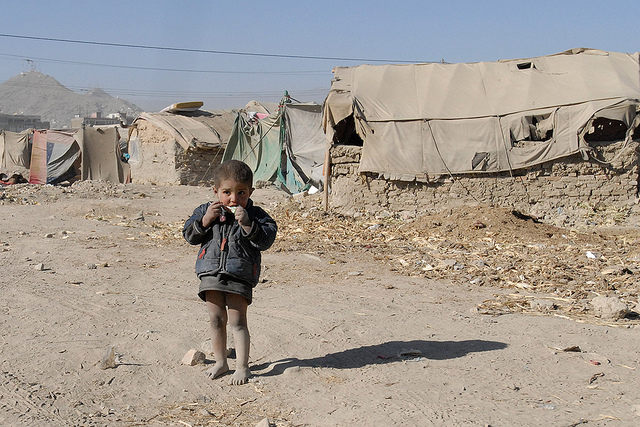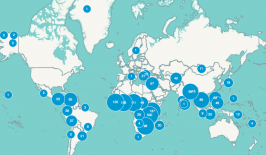Restrictions on movement and the banning of large gatherings of people during the Covid-19 pandemic means that protests and demonstrations can no longer take place. So how can citizens have their voices heard, protest injustice and take a stand for change? We asked one activist exploring innovative online paths to demonstrate for refugee rights during the lockdown.
The Covid-19 pandemic has had a huge impact on the everyday lives of people across the globe, with billions now in lock-down under various different isolation regulations. Although much airtime and editorial space has been dedicated to the impact of these restrictions on the economies and social structures of the countries affected, many other important aspects of civil society are also struggling to navigate this unprecedented time.
Take for example activist movements. Traditionally, these rely on mass gatherings in public space to publicise their causes and put pressure on government actors. However, restrictions on public gatherings have quashed any hopes of such traditional tactics. Therefore, leaders and participants in both local and global protest movements may need to adjust their protest strategies during the coronavirus period. One such individual eager to identify new strategies despite lockdown regulations is Yunus Berndt, a social activist who has developed an innovative way for protest movements to continue to be seen on the streets, while abiding by social distancing conventions.
Peopleless Protest – or Personless Protest – is a concept -which as the name suggests – involves protesting without people. Instead, those wishing to advocate for various causes can use symbols and social media as a means of keeping protest movements alive.
In early March, Yunus was part of the Europe Must Act movement which aimed to organise pan-European protests in the spring to highlight the plight of refugees confined to cramped camps on islands in the Aegean Sea. As the virus began to take hold on the continent – first in Italy and then elsewhere – European states began to introduce regulations banning mass gatherings, putting an end to Europe Must Act’s immediate plans.
Faced with this, Yunus developed a new idea to keep the Europe Must Act message alive. This idea consisted of three elements: a marker, a record and an assembly.
A marker is a symbolic object which can act as surrogate for a person in a protest movement. The marker should stand out from its surroundings in order to catch the eye and more clearly convey a meaning – for example a striped flower pot or a silhouette drawn with chalk on the pavement.
The next step is to record this marker, for example with a photograph and post it to social media or to a dedicated website.
Finally, all these records should be collated together and displayed in a unified location to replicate the nature of a protest – but in an online space. This could be a social media hashtag or pins on a map showing the locations of the markers. So although the individuals behind the markers may have never met in reality, their representatives can come together on the internet.
Ultimately, Yunus decided to use the silhouette as a marker for his Peopleless Protest in support of Europe Must Act. Not only did the silhouette stand out starkly in public, but it also respected individuals’ privacy while standing as a symbol of those who could not literally be out on the streets. The various silhouettes, some in chalk and others on paper, were then collected together and pinned on a map on europemustact.de.
The idea has taken off, and Seebrücke, a leading German organisation advocating for the rights of refugees crossing the Mediterreanean, have adopted similar ideas to continue to keep their protests visible during lockdown. RESET spoke with Yunus to discuss the concept of a Peopleless Protest, as well as how the Covid-19 pandemic has affected the activist movement.
So Yunus, what unique challenges to protest and civil society organisations has the Covid-19 pandemic created?
You might think that protest movements can easily move to social media, use channels they have anyway and thereby continue their work online. But that neglects the fact that the social media machine works differently. You are competing on social media with hundreds of other things – ads, personal postings, other campaigns – for users’ attention. That makes it difficult for small initiatives.
Added to this is the fact that people currently have to sit a lot in front of their screens, for work or study, and are therefore reluctant to stay online additionally for social or political causes. Of course, there is a hard core of activists who do not mind, but those people – ones who are already inspired by your cause – are precisely the circle of people you usually wish to go beyond. The people on the fringes of the activist circle can be described as passivists: They support the cause, but they do not burn for it like the activists. In normal circumstances, they would occasionally join a demonstration because a friend or flatmate goes. For them, it is primarily a social event and secondarily a political urgency. This social element is now lost in the virtual sphere.
When it comes to organisations, there are a range of constraints arising from Covid-19. There is the time inevitably lost in restructuring and additional communication from home offices, the decimation of field teams – especially of humanitarian workers on the ground who had to fly home, and, often, the dire financial outlook.
How have the restrictions on movement and gathering in particular affected protest movements?
In established democracies, democracy is ‘on hold’. That does not mean that democracy is suspended but that we postponed extra-parliamentary political discourse into the future. In that sense, many movements are not killed by the pandemic, but rather forcibly paused.
Thus, in established democracies, movements will be back on the streets as soon as the pandemic is over – or sooner. However, I don’t think the come back will be easy: Campaigns need to build new momentum, and movements that ask for a shift in resource allocation will have a hard time. You will struggle to ask for investments in climate justice if your government has just overburdened itself with debt.
Could this impact continue after the pandemic? What are the long-term term risks to protest movements in the future?
I anticipate that we will not have any radical changes due to the pandemic, at least in the wealthier nations. We will rather experience a continuum of pre-crisis trends. Authoritarian developments, as we find them in China and, alarmingly, also in Hungary, will be facilitated, fostered and accelerated by the crisis, but we have observed these trends already before. So activists in these countries continue to struggle with their regimes and they need to continue their quest for creative ways to raise their voices.
In democratic societies, I believe the public pressure is strong enough to restore some form of the status quo. Everyone inherently knows that we are living an exception which will be over one day. That return to the ‘normal’ is fortunate in some cases, less so in others, like for the environment.
If people are under strict restrictions but still want to make their voice heard regarding certain issues, what advice would you give them?
Excellent question. Katharina Balazs, professor at the European School of Management, writes that crises cause people to cultivate a “fear of a narcissistic injury, of having to acknowledge that the present state of affairs is not good enough, [which] can contribute to a frozen stance [where] we seem to prefer the familiar ‘bad’ to the promising unknown.”
So, here we have a situation that is exceptional, and some activists might tend to regard it as ‘not good’ times for demonstrations, extra-parliamentary opposition, for any form of protest. As I said, they put democracy on hold, they self-censor, or, as Balazs says, they ‘freeze’. Yet that is a mistake and a true danger for democracy.
Overly relying on the familiar – and physical – tools of political participation that are inadequate or ‘bad’ tools at the moment, and waiting for their right time to come, is as irresponsible as using them now against any common sense. Rather, we should embrace the ‘promising unknown’, explore new opportunities and innovate in the wake of Covid-19.
Peopleless protests are one such innovation that allows protest even in times of strict curfews, and I am working to eliminate one of its major shortcomings, that is, the lack of social interaction. But I am looking forward to seeing many other new forms of protest popping up in the weeks, maybe months to come. The time to innovate is now.
Europe Must Act is continuing to ramp its online activities, demanding for the immediate evacuation of the refugee camps in the Aegean and a relocation of asylum seekers across Europe. Head over to europemustact.org for more information and to get involved.
For more ideas on how you can lend a hand to others and show solidarity online during the Covid-19 crisis, check out our article here.






